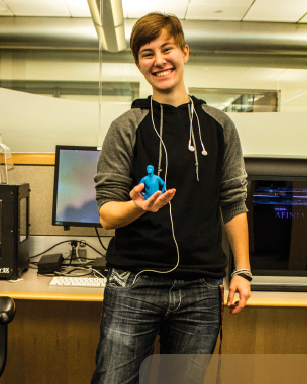In his 2013 State of the Union address, President Obama spoke of the developments in 3D printing, a new medium of technology that uses computer-generated digital prototypes to form real objects. In the spring of 2014, Wellesley’s Knapp Media and Technology Center added new Maker tools, including 3D printers, to their collection of equipment available for use by members of the college community.
In order to encourage more students to utilize this technology, Knapp Media Center media interns and staff recently created Wellesley’s first 3D printing organization, Make Club. Founded by Anna Pfoertsch ’18 and sponsored by Instructional Technologist Jordan Tynes, the organization seeks to promote a collaborative environment where students can explore new mediums of technology.
Pfoertsch’s interest in innovation and her internship with the Knapp Media Center culminated in a fascination for 3D printing.
“Being able to transform a cluster of pixels into a tangible object seems so science-fiction that when I first discovered 3D printing, I couldn’t believe my eyes,” she said. “Now with the rapid advances in 3D printing, it is vital to keep up to date with the newest technologies, encouraging me to establish an org, where students can experiment with these new developments.”
Pfoertsch explained that she wanted to start a 3D printing club in order to encourage more students to learn how to use this technology.
“Since I work in the Knapp Media Center and work with 3D printers on a daily basis, I saw how underused they were and really wanted to spread the word about what technologies are available to us,” said Pfoertsch. “Ultimately, I would like all Wellesley students to be aware of the resources available to them on campus, but also allow students to learn and experiment with a new technology, such as 3D printing.”
According to Pfoertsch, the main goals of Make Club are to expose students to the possibilities of 3D printing.
“In a collaborative environment, students will learn all about 3D printing — from how the printer is made and the programs used to make a 3D printable model to the final step of creating a tangible product,” she said. “Community members at all levels of familiarity and of different backgrounds are welcome to join. All that is needed is an interest and passion to learn.”
Madeleine Barowsky ’18, a member of Make Club, elaborated on how she became interested in 3D printing.
“During orientation I saw the 3D printers in Knapp making the keychains and wanted to learn more. I think it’s so fun to watch the printers create things layer by layer, and I enjoy all the possibilities of printing with novel materials. One day we’ll have 3D-printed food and organs!” she said.
Although the organization is titled “Make Club,” Pfoertsch hopes to expand the projects and allow students to explore any new technology in which they are interested. The organization meets on a biweekly basis, therefore allowing students to individually experiment or work on their projects between meetings. During their meetings, members discuss current and upcoming project ideas and collaborate to troubleshoot technical issues. Members also present the projects they have created and reflect on the challenges or strategies they encountered in creating such objects in order to improve future 3D projects.
Because the organization is an extension of the Knapp Media and Technology Center, members use the 3D printers provided by Clapp Library. Students are allowed to print 3D objects that are less than five grams for free, but anything greater than that must be paid for. The larger the object being printed, the longer it also takes for the entire procedure to go to completion.
According to Jennifer Chien ’19, another member of Make Club, one of the challenges of 3D printing is the detailed thought process that printing such objects requires. She explained this concept by providing an example of how to 3D print a bowl.
“The machine basically prints in layers from bottom to top — like cutting layers of paper and stacking them on top of each other. So if I was to try and make a bowl, then it would take much longer because the machine would have to build scaffolds and supports because it can’t build a layer on top of nothing,” she said. “However, if I were to build the exact same bowl upside down, then it would be easier because you are building a layer on top of the next.”
Regarding the future of 3D printing, Pfoertsch is confident that this new innovation is an important advancement in the future of technology.
“Right now, 3D printing is clumsy, results can be clunky and the printers are expensive. Even so, I do believe that 3D printing is an important advancement, as it is bringing the spirit of creation and innovation back into the average household,” she said. “Its accessibility in being easy to learn allows students of all ages to experiment with 3D printing, while the great range of products you can create, from makeup to robots, appeal to a wide variety of social groups.”






